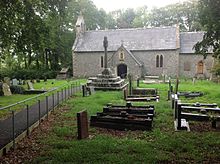Canna | |
|---|---|
 St Canna's Church, Llangan | |
| Died | 6th century Wales |
| Feast | 25 October |
Canna was a sixth-century mother of saints and later a nun in south Wales, to whom two Welsh churches are dedicated.
Canna | |
|---|---|
 St Canna's Church, Llangan | |
| Died | 6th century Wales |
| Feast | 25 October |
Canna was a sixth-century mother of saints and later a nun in south Wales, to whom two Welsh churches are dedicated.
According to the writings of the unreliable Iolo Morganwg, Canna was a daughter of King Tewdwr Mawr of Armorica (modern-day Brittany) and Cornwall. She was the mother of Crallo and Elian. [1]
Canna was reputedly the sister-in-law and cousin of Illtud, and possibly established the church at Llangan, near Llantwit, due to its proximity to him. She married Sadwrn, her first cousin or uncle; together they accompanied Saint Cadfan to Britain and founded two churches, one in Carmarthenshire and another in Anglesey. [2]

At St Canna's Church in Carmarthenshire, there was a holy well below the old church called Ffynnon Ganna, whose water was believed to have curative properties and was a site of pilgrimage for many centuries. The holy well is no longer extant. There was also a stone known as Canna's Chair, with an undated inscription possibly reading CANNA, in a field near the churchyard. [2]
Her name also appears as part of two Cardiff districts: Canton (English translation of the Welsh Treganna, Saint Canna's Town); and Pontcanna (Welsh for Canna's Bridge). [3]
Canna's feast day is celebrated on 25 October. [4]